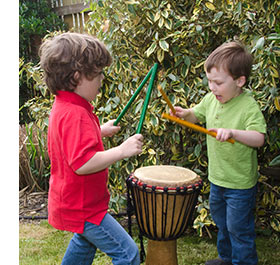|
 Our
ears are cleverly designed to scoop up the sound around us and
deliver it to our brains without us having to lift a finger- even as
we sleep! They work tirelessly and effortlessly to interpret our
world through their delicate and beautifully complex design. So it’s
ironic that the very thing they are designed to welcome in (sound)
can also inflict irreversible damage. Our
ears are cleverly designed to scoop up the sound around us and
deliver it to our brains without us having to lift a finger- even as
we sleep! They work tirelessly and effortlessly to interpret our
world through their delicate and beautifully complex design. So it’s
ironic that the very thing they are designed to welcome in (sound)
can also inflict irreversible damage.
Too much of a good thing
Although they are designed to last a lifetime, our increasingly
noisy world puts us all, and especially children, at risk for
“noise-induced hearing loss,” or NIHL. Noise-induced hearing
loss is irreversible. It is also totally preventable
Now Hear This!
-
Noise-induced hearing loss is
permanent (this bears repeating)
-
Noise-induced hearing loss is
totally preventable (this definitely bears repeating)
-
Infants are more susceptible
to NIHL because their skulls are thinner
-
Faced with long-term exposure to
loud noise, the only ways to prevent NIHL are to
Walk
away, (distance from loud noise decreases danger)
Reduce the volume ( The American
Academy of Audiology made
this cool rap video as part of their
“turn it to the left” campaign to try to reach teens damaging their
ears with devices like I-pods.
Cover Your Ears Sound protection
ear muffs are made for all ages, including babies, and once the risk
of choking is past, ear plugs can be used- for you too!
Babies and young children are
dependent on us to protect their hearing. They can’t walk away when
the noise at a
professional sports game, loud music, or ear-splitting sound from a
movie assaults and threatens their hearing.
Babies and young children are dependent on us to protect their
hearing. So educate yourself and take action!
How loud is
TOO LOUD?
The technical answer is, anything over 85 decibels (the way we
measure volume) can do permanent damage.
Here’s a
link with a good list of common sounds and the risk they
present.
A good rule of thumb is that if you can’t hold a conversation over
the noise/music, it’s probably too loud.
Remember these “three D’s”
-
DECIBELS (volume):
anything over 85 (for example, a garbage disposal).
-
DURATION: how long you’re
exposed to loud sound
-
DISTANCE: How close you
are to the sound
Noise-induced hearing loss is accumulative over
a lifetime, so preventing hearing loss in children is especially
critical.
Everyday Sounds that
Can Lead to NIHL,
and What You Can Do to Prevent it
-
Sports
games at public stadiums- Make sure children are wearing ear
protection. Ear muffs are made to fit
infants and children.
-
Toys:
Many toys are over 85 decibels: A squeeze toy is 90 decibels. If a
toy seems too loud to you, it probably is. An easy fix it to place
apiece of scotch tape over the speaker. You’ll be amazed at how much
this cuts down the volume.
-
White noise
machines for babies: these can be alarmingly high decibel, so
move them away from baby out of the crib or on the other side of the
room
-
Movie and
television sound- keep volumes below 85 decibels
-
Parties
with loud music- try to stay as far away form the source as
you can
Children are drawn to audio speakers! So when you’re at a concert,
or at home, make sure they don’t crawl or walk up to a speaker and
place their ear next to it.
|



 Our
ears are cleverly designed to scoop up the sound around us and
deliver it to our brains without us having to lift a finger- even as
we sleep! They work tirelessly and effortlessly to interpret our
world through their delicate and beautifully complex design. So it’s
ironic that the very thing they are designed to welcome in (sound)
can also inflict irreversible damage.
Our
ears are cleverly designed to scoop up the sound around us and
deliver it to our brains without us having to lift a finger- even as
we sleep! They work tirelessly and effortlessly to interpret our
world through their delicate and beautifully complex design. So it’s
ironic that the very thing they are designed to welcome in (sound)
can also inflict irreversible damage.